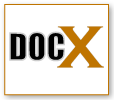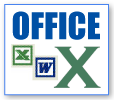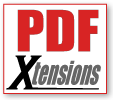Document Extensions
Add complete document management to any SAFE transaction
Document Xtensions (DocX) provides transparent linking of any number of documents to any Simple Accounting transaction. This allows sales, accounting and support and management to share and track all the electronic files that are a part of any Transaction.
How It Works
DocXtensions is completely transparent. After installation it adds a simple Linked Documents button to the all transaction browse screens.
Setup Options
DocXtensions has to be able to find the documents you want to link to various Simple Accounting Transactions. The easiest way to do this is to scan documents directly into Simple Accounting using the Scan button inside every Linked Document Window. Any document scanned directly into Simple Accounting is automatically linked to it’s Transaction and can never become detached.
Of course, you can also scan/create documents outside of Simple Accounting. You also have many documents already in storage that need to be linked to Transactions. So then you need to tell Simple Accounting how to do this ‘linking’. And that right there is the big setup question: Where are you going to store the linked documents? You have to give Simple Accounting a set of rules to follow for cataloging and retrieving linked docs. And then (just as important!) your users have to follow those rules. So again, it’s critical that you/we decide how to do this in a way everyone finds convenient and can adhere to.
Storage Locations
It is recommended that you set up a single shared folder for all documents to be available for DocXtensions. Although this is not strictly necessary, it will make management outside of DocXtensions easier.
Naming Options
It is also necessary to decide on how to name files that will be shared. What you/we need to decide is some sort of structure that everyone finds convenient and can adhere to.
Here are the four most commonly used options. Decide from one of these and you’re half way home:
-
Create a separate folder for each Transaction
The default rule in Simple Accounting. You then scan and review files within that assigned folder. So when you review a Transaction #123456, you are given a list of files located in that folder. This offers a big advantage over other options in that any file, of any type, that you drop into a folder automatically gets linked to the Transaction. So it’s a very easy rule to follow. It is also the fastest -executing- option. ie. when you click ‘View Documents’ the list is retrieved faster because Simple Accounting has only one place to look for files.
-
Separate Folder By Document Type
Now as we said, the current ‘P’ drive is definitely -not- organised by Transaction ID. So another option is to store files by Transaction ID ie. we can create a set of rules that say ‘all XLS files go in folder “Spreadsheets”, all JPGs go in folder “Pictures”… etc.’ If you name the files according to the -rule- Simple Accounting will automatically link to each file. … ie… 123456-1.jpg and 123456-2.jpg will be linked to Transaction #123456.
-
Separate Folder By Transaction Type
Another option is to store files by -functionality-: eg. ‘/estimates’, ‘/billings’, ‘/inspections’, ‘/insurance’, etc. And again, if you name the files according to a -rule- Simple Accounting will automatically link to each file. … ie… all XLS files name 123456-1.xls and 123456-1.jpg will be linked to Transaction #123456 no matter where they are.
-
Manually
And finally, you can link files -manually- and put them wherever you want. -However- that means the person assigned the Transaction of linking the files to each Transaction in Simple Accounting will have some work to do! Also, experience has taught us that if you allow users to drop files ‘anywhere’ that means you need to assign someone to routinely locate new files and keep manually linking them to Transactions.
Remember that these options are is necessary mainly if your users are going to be creating and accessing documents outside of Simple Accounting. Again, Simple Accounting has to be linked to the documents. If you copy files from a new Transaction into a folder called ‘photos’ but don’t give Simple Accounting any idea what those JPGs are -for- it can’t help!
Three Steps
So setup involves 3 steps:
- Determine which rules your people will find most convenient (option
a-d) and give them the procedure to follow. - Have someone (or us) do any file re-organisation and re-naming so that the current files conform to this system. We can then link these existing files to their Transactions for you.
- Then we configure Simple Accounting to follow those rules so that it automatically shows you the proper files… and when you scan files directly in Simple Accounting it places them in the right places.
From that point on, new files not scanned from Simple Accounting are added by your users according to the selected rule. Then Simple Accounting either automatically links them to their Transactions (option a,b or c) or an assigned user periodically scans for new files and links them manually (d).
Security
Documents may be limited to Employees by their assigned Simple Accounting Security Template. Each Employee may be limited to a range of transactions in the following ways:
- By Transaction Type
- By Assigned Employee
- By Document Type
- By Transaction Type
E-Mail Connection
When e-mailing PDFs, you can also attach other files such as graphics. So when you e-mail a PO for a given product, you not only attach the PDF, but also any artwork files you have already linked to the product in SAFE (remember how we did that in our last issue?) You now have a fool proof way to ensure that your vendor gets all the materials he needs to print your Transaction; every time.










